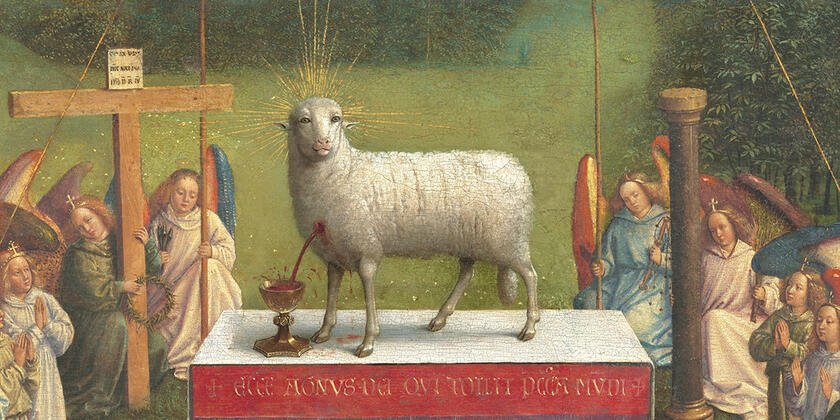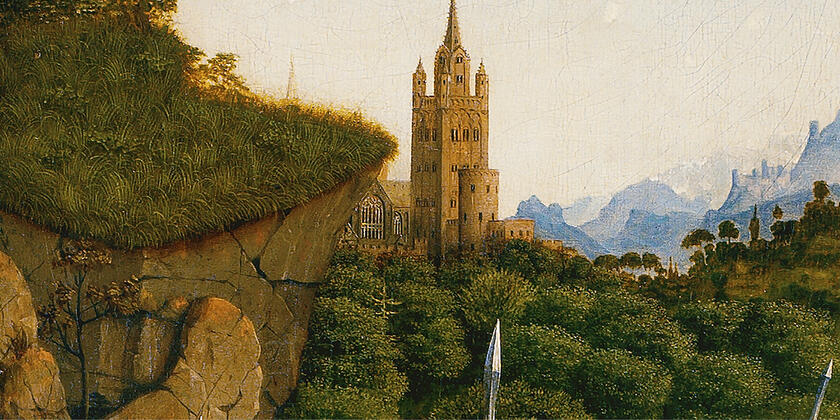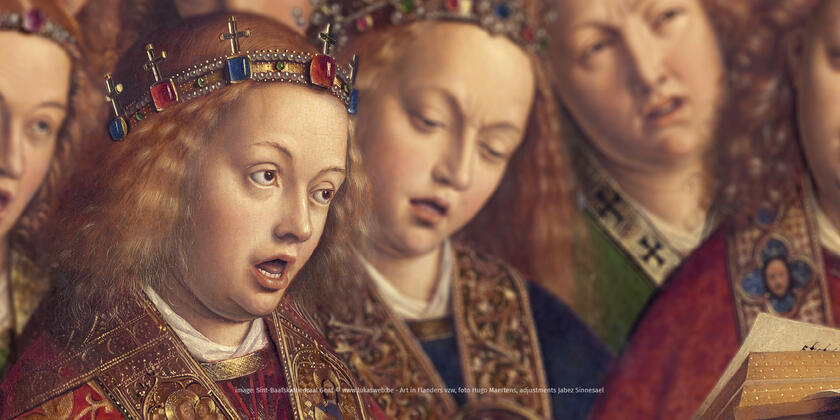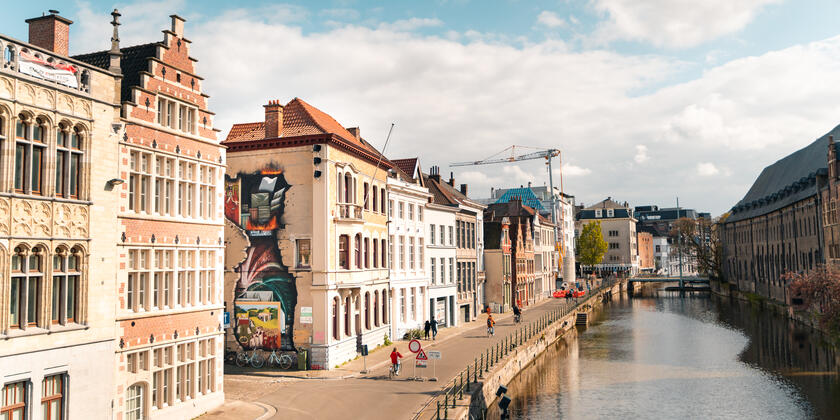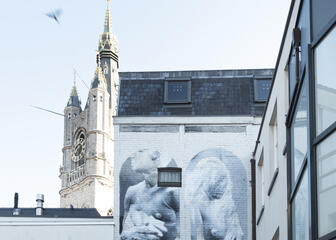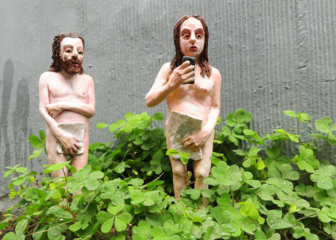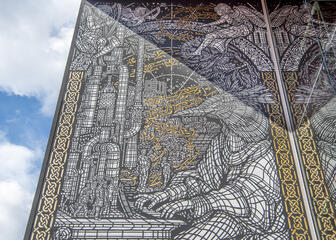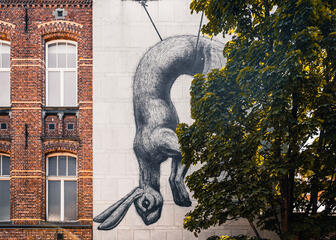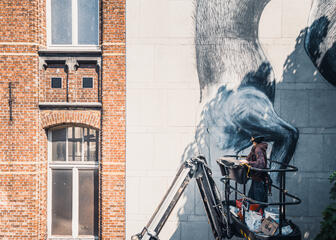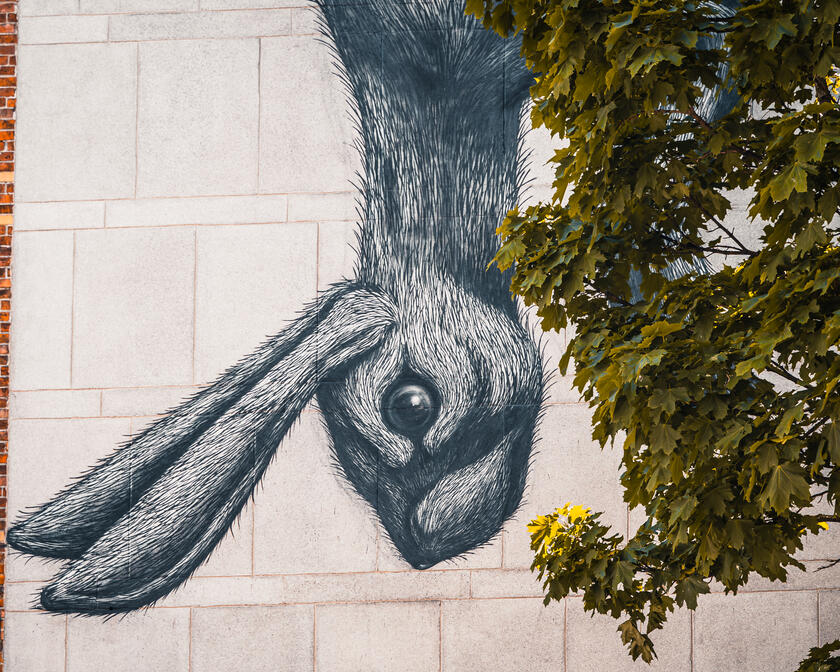
The city as one blank canvas
In Ghent, several national and international artists have drawn inspiration from Van Eyck and his most important work: the Adoration of the Mystic Lamb. The result is an impressive series of street art with a remarkable story that waits to be discovered.
Isaac Cordal - lonely in society
Scattered throughout the city center
Spanish artist Isaac Cordal was inspired by the outermost panels of the Ghent Altarpiece’s upper register, depicting Adam and Eve, the biblical progenitors of humanity. There are 15 miniature couples scattered throughout the city center along the street, high above a doorway, on the windowsill, etc.
Isaac Cordals works can be found in the streets of London, Berlin, Paris, Barcelona, Brussels, ... You have probably walked past them without noticing anything. The statuettes are tucked away on facades, electricity cables, drains and other unexpected places. In this way the artist emphasizes the loneliness and isolation of modern times. His work is a critical reflection on our behavior.
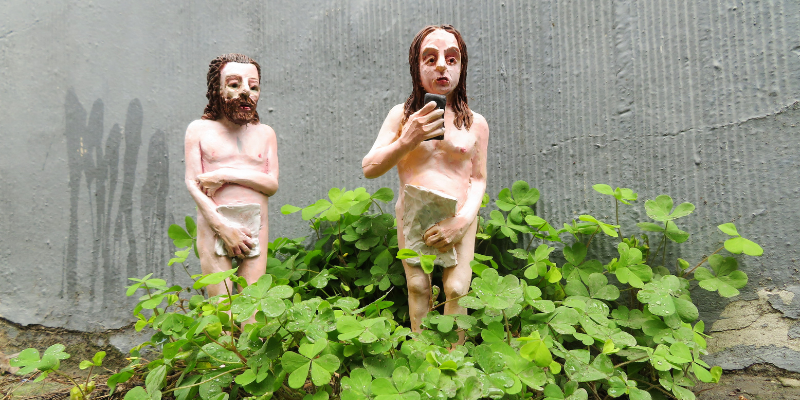
Hyuro - surrealism with a message
Bij Sint-Jacobs
Within walking distance of St Bavo's Cathedral, the Van Eyck mural by Argentine artist Hyuro adorns the corner of Bij Sint-Jacobs. Hyuro is known for her dreamlike, surrealistic compositions in which women often play the leading role. The soft colors in her work give her pictorial style an intimate and delicate atmosphere. She also remained true to her recognizable style for her interpretation of the Mystic Lamb on the facade of the antique shop Dino Antiques.
With the sheet, which covers three people, Hyuro makes the link with the rich fabrics and robes that can be seen on the Ghent Altarpiece. The floral motif is a nod to the botanical splendor on the Altarpiece. The artist also likes to incorporate a political message in her works. With this 'mural' she wants to raise the refugee issue and the way in which the politics deal with it.

Read more about the wealth of plants depicted in the Ghent Altarpiece
Pastel - flora in the city
Kuiperskaai 14
Near De Krook, you can also find Van Eyck-inspired street art. An Argentine artist just like Hyuro, Pastel gave the rear of the building located at Kuiperskaai a thorough makeover. His work "Pilgrims Pot" is largely inspired by the Ghent Altarpiece. We previously saw the flowers - roses, lilies and columbines - on the Mystic Lamb on Mary's crown. The flowerpot was decorated with the background of the panel with the pilgrims.
Pastel's work can be defined as "Urban acupuncture" in which he uses murals as the start of renewing non-places, starting from the local identity of the place, the flora.
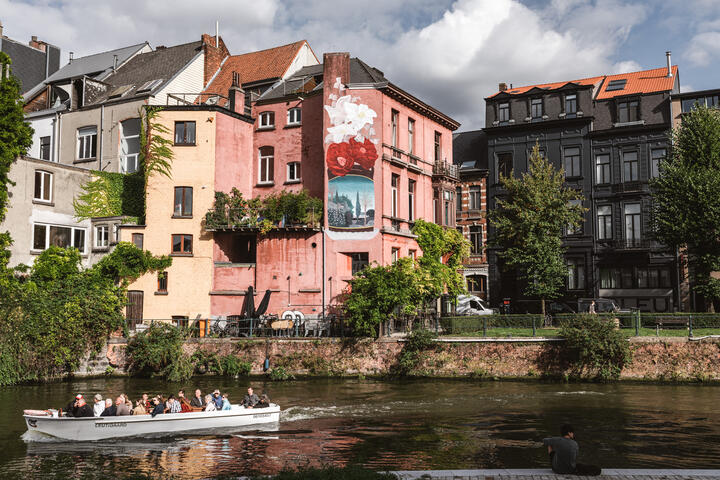
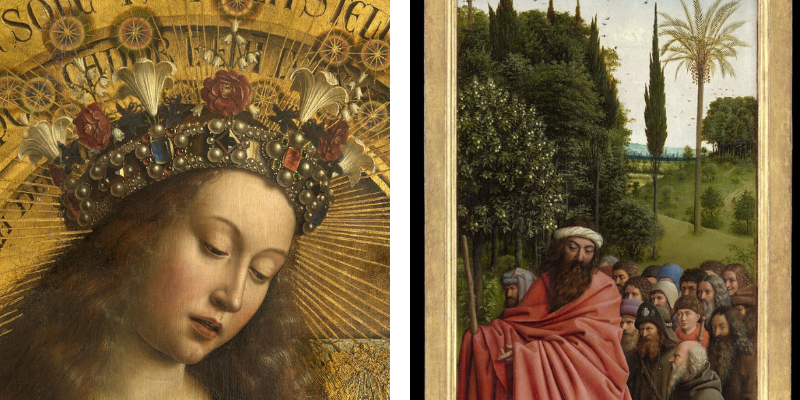
Strook - serene silhouettes
Braderijstraat
Belgian artist STROOK, known as Stefaan De Croock in everyday life, represents the local art scene. He pays tribute to Van Eyck and the Ghent Altarpiece with a diptych in Braderijstraat.
At first sight his work shows us two figures that are depicted diagonally opposite each other. Actually it is one single person looking in the mirror, in confrontation with itself. Whereas Van Eyck chose themes in religious spheres, De Croock clearly opts for a more personal approach. A nice fact: the work of art is really Ghent. STROOK used recycled scrap wood from St Bavo's Cathedral, LUCA School of Arts, a former supporter café of KAA Ghent and the Leopold Barracks.
The artist, who himself studied at LUCA School of Arts, is known for his subdued silhouettes from weathered wood, which was degraded by time. His work could already be seen from Watou to Mexico City.
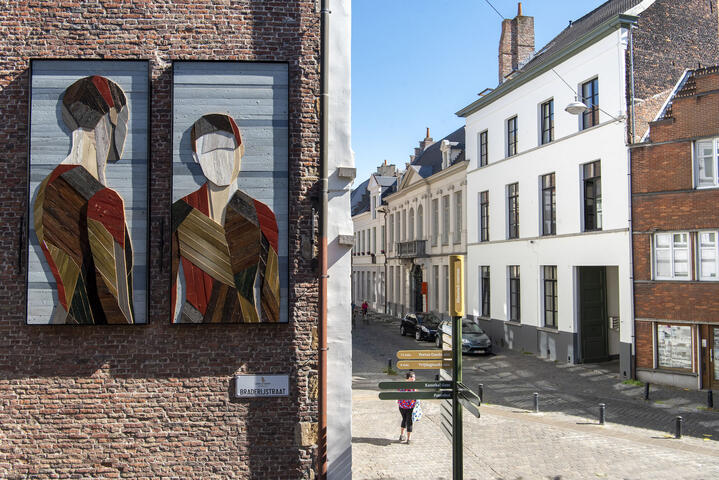
Bosoletti - desencuentro
Mageleinesteeg
Argentinian-born artist Francisco Bosoletti created the mural Desencuentro in the picturesque Ghent alley Mageleinsteeg (side street of Lange Kruisstraat). For the work, Bosoletti tried to look at the Ghent Altarpiece through the eyes of the van Eyck brothers themselves. The panels depicting Adam and Eve attracted his attention right away. They seem to embrace all other elements of the historic masterpiece. Bosoletti states there would not have been a story if Adam and Eve had not met, and applies this theory to our own reality: every single encounter we have may change the course of our history.
Bosoletti was born in Armstrong, a small village in the Argentinian province of Santa Fe. He currently works from Italy, where his work has garnered considerable attention. He is quite renowned in the international urban art scene and has participated in various projects in Europe and America.
You can no longer see this mural at this location.
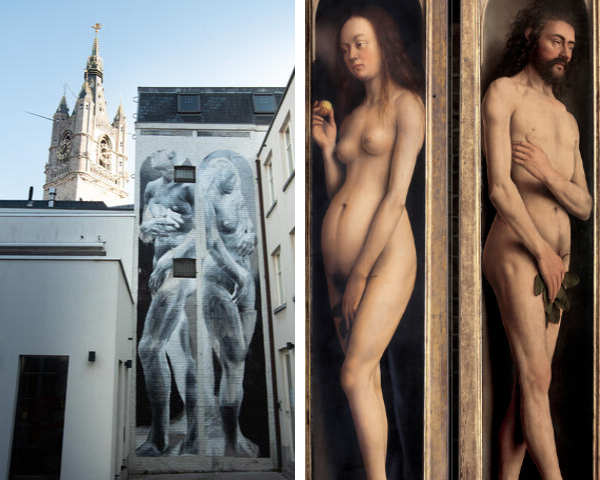
Monkey Bird Crew - music and instruments
Across the water at the Ketelvest
‘La Sonate du Canal' (The Canal Sonata) is created by the French duo Monkey Bird Crew. The work can be admired on the back facade of the Handelsbeurs (across the water at the Ketelvest). Monkey Bird Crew has created a visual link with the music and musical instruments used at the time of the Mystic Lamb and Van Eyck. The monumental Handelsbeurs building, in which Handelsbeurs Concert Hall is located, fits perfectly within that theme.
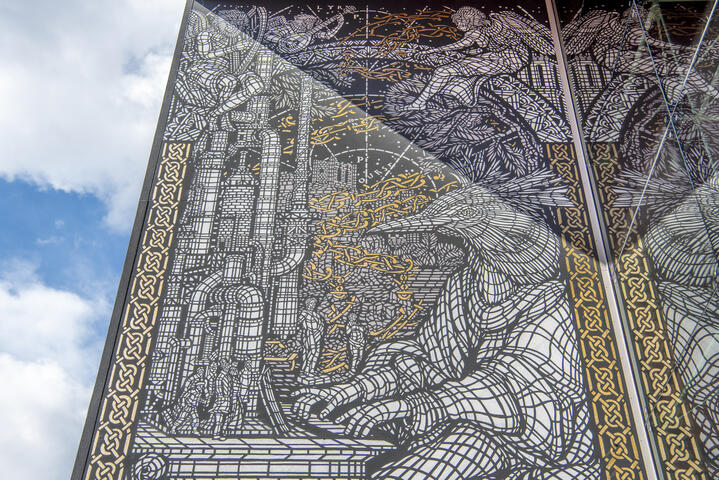
Read more about the music on the Mystic Lamb
Taquen - Jan Van Eyck
Facade of buildings VisitGent, Old Fish Market (only visible from the Castle of the Counts)
Spanish artist Taquen converted an blind wall at Oude Vismijn into a true work of art. The mural is inspired by ‘the ‘Portrait of a Man in a Red Turban’, which is thought to be a self-portrait by Jan Van Eyck. This mural in soft pastel and earthy tones blends in perfectly with the city’s historical background. Can you guess where this new hidden treasure can be seen from? If you want to enjoy an unforgettable view, then climb the stairs in the tower of the Castle of the Counts.
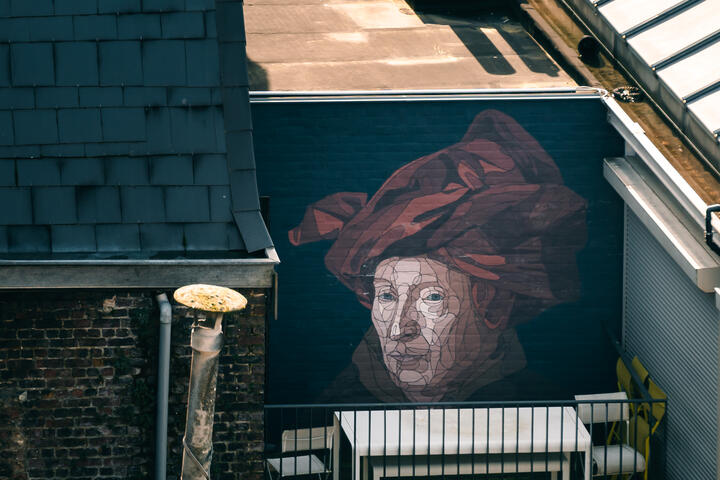
Cee Pil & Blommm – John the Baptist
Vrijdagsmarkt 11
Artist Cee Pil drew inspiration from one of the central panels of the Ghent Altarpiece, depicting John the Baptist. In cooperation with flower shop Blommm, he created a piece of Van Eyck graffiti art on the side wall of the building at the address Vrijdagmarkt 11.
Cee Pil is known for his 'glitch'. In his work he merges two images into one another. John the Baptist has the same glitch however Blommm covered the work with flowers, which results in a unique combination.
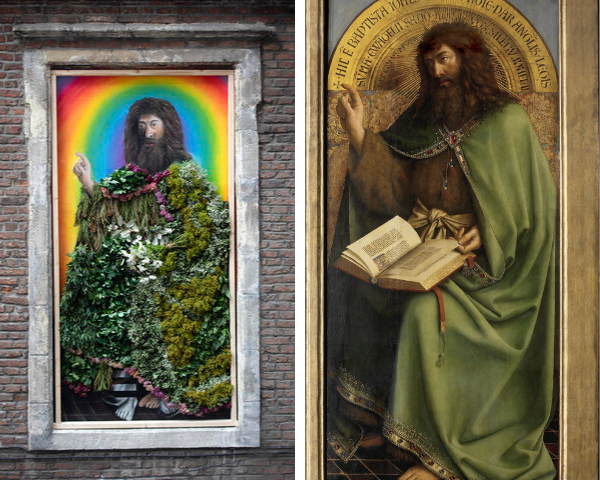
ROA
Oude Houtlei
Street art artist ROA created a monumental work on the facade of the Sint-Lucas campus in the city centre. This work, a sculpture of a hare, is based on the metaphorical meaning of the atoning sacrifice, a theme that can also be found in the Ghent Altarpiece by the Van Eyck brothers. The Lamb is the personification of Jesus, who sacrifices his life to save humanity from its sins. The hare is also an iconic animal that regularly recurs in ROA's oeuvre. It symbolises rebirth and rebellion.
ROA has been active for more than 20 years and belongs to the top of international street art artists. The artist with Ghent roots works in complete anonymity while his works can be found all over the world. He is known for his detailed black-and-white images of rodents, birds, reptiles and endangered species.

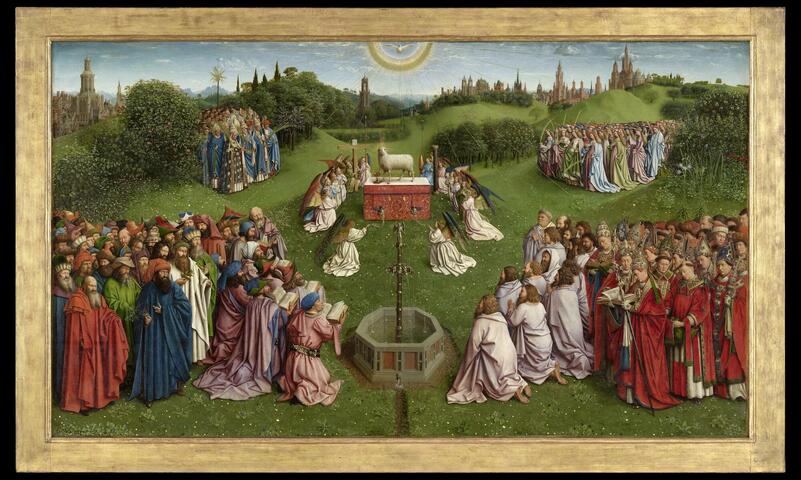
Smates - The Monuments Men
Corner of Predikherenlei and Van Stopenberghestraat
The Ghent Altarpiece has had an eventful history. For instance, the Ghent masterpiece was saved from destruction by the Nazis during the last days of the Second World War. Adolf Hitler had ordered the panels to be taken to a new Super Museum to be established in Linz, the town where he grew up. Because of Hitler’s impending defeat, he gave the order to take the works of art to the Altaussee Salt Mine in the Austrian federated state of Styria and blow them up with dynamite. A group of brave Austrian mine workers, known as the ‘silent heroes’, foiled this diabolical plan. The film ‘The Monuments Men’ directed by George Clooney is based on this true story. On the occasion of the release of the film, graffiti artist Bart Smeets created a large mural on the side wall of a town house on the corner of Predikherenlei and Van Stopenberghestraat, near St Bavo's Cathedral.
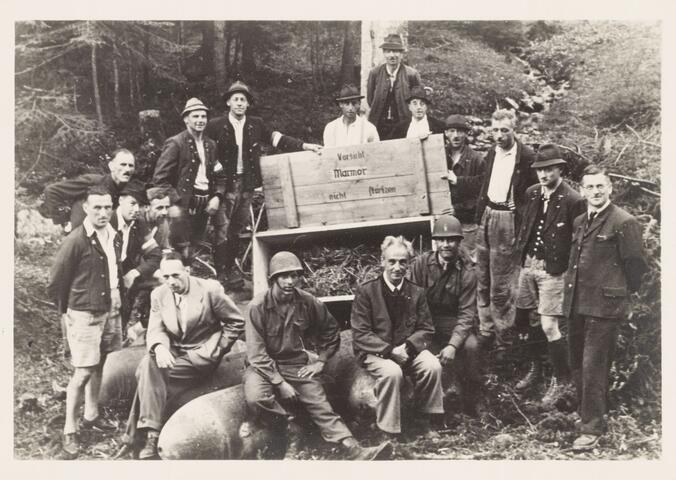
The Ghent street art map
Can't get enough of street art? Under the label SORRY, NOT SORRY, the City of Ghent supports street art all year round, with the most visible examples being the large murals that can be admired throughout the city. Explore the Ghent murals using the street art map.
Sorry, Not Sorry - Street Art Map Gent
Fans of street art are in luck with this map showing all kinds of outdoor art. The walk along street art in the city centre is doubly interesting, as this tour is not only an introduction to Ghent’s street art, but also brings you to some tourist highlights. Ghent’s street art scene is booming and fits in wonderfully with the historical city.
Available in 3 different languages: Dutch, French and English
A paper version of this brochure is also available in the tourist office.

